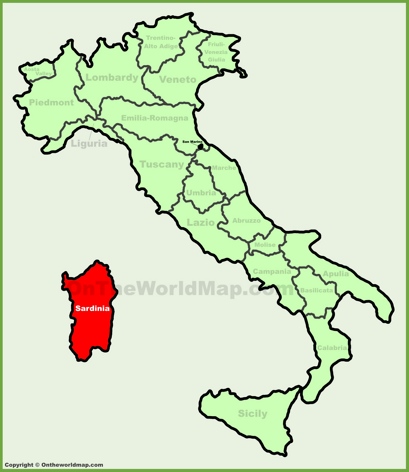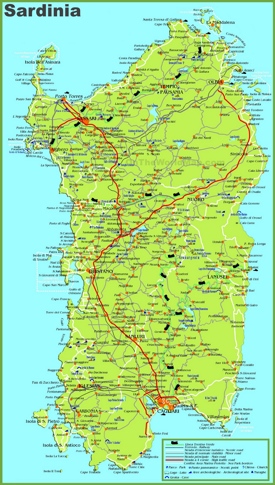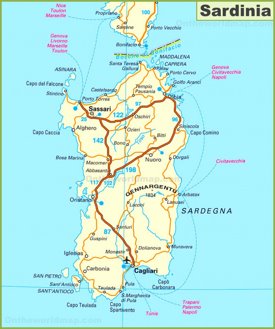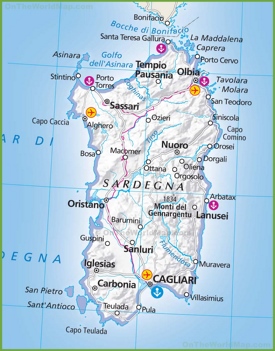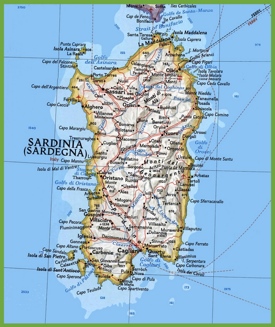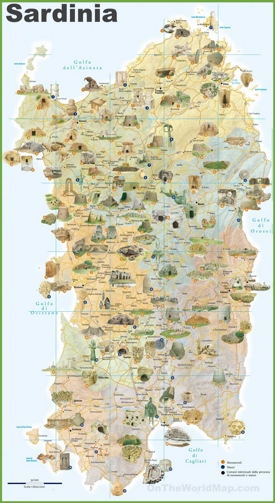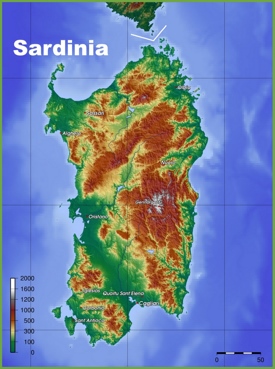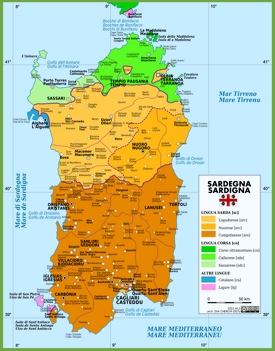Sardinia Map
Description:
This map shows provinces, province capital cities, major cities and towns, and islands on Sardinia.
Size: 1000x1320px / 413 Kb
Author: Ontheworldmap.com
You may download, print or use the above map for educational, personal and non-commercial purposes. Attribution is required. For any website, blog, scientific research or e-book, you must place a hyperlink (to this page) with an attribution next to the image used.
Online Map of Sardinia
About Sardinia
Sardinia is an island in the Mediterranean Sea, located west of the Apennine Peninsula between Sicily and Corsica, and is the second largest island in the Mediterranean Sea. It is part of Italy as a region. Sardinia has an area of 9,300 square miles (24,090 square kilometers) and a population of 1,564,885[1] as of 2024. The capital is the city of Cagliari. Sardinia is divided into four provinces: Cagliari, Nuoro, Oristano, and Sassari. Most of Sardinia is traditionally spoken in dialects of the Sardinian language.

Sardinia is famous for its natural beauty and offers many outdoor activities. Beaches, the island's picturesque coasts such as Costa Smeralda, La Pelosa and Cala Luna are renowned for their crystal clear waters and white sands. The Maddalena Archipelago, a group of islands off the northern coast, is a protected national park known for its stunning seascapes and diverse wildlife.


For nature enthusiasts, the island's interior offers hiking opportunities in the Gennargentu National Park and the Supramonte mountain range. The Grotta di Nettuno, a spectacular sea cave near Alghero, is another must-see natural wonder.



Sardinia boasts a diverse landscape, ranging from rugged mountains to pristine beaches. The island is surrounded by the Mediterranean Sea, with the Tyrrhenian Sea to the east and the Balearic Sea to the west. Its coastline stretches over 1,800 kilometers, featuring a mix of sandy beaches, rocky cliffs, and hidden coves. The island's interior is characterized by rolling hills and the Gennargentu mountain range, which includes Punta La Marmora, the highest peak at 1,834 meters.
The climate in Sardinia is typically Mediterranean, with hot, dry summers and mild, wet winters. Coastal areas enjoy a more temperate climate, while the interior can experience more extreme temperatures.
Sardinia has a rich history that dates back to prehistoric times. The island is dotted with over 7,000 nuraghi, mysterious stone structures built by the Nuragic civilization between 1900 and 730 BCE. These ancient towers are a testament to the island's early inhabitants and their architectural prowess.
Throughout history, Sardinia has been influenced by various cultures, including the Phoenicians, Carthaginians, Romans, Byzantines, and Spanish. This diverse cultural heritage is reflected in its architecture, languages, and traditions. The island has its own unique language, Sardinian, which is recognized as a minority language alongside Italian.
Sardinian culture is rich in traditions, particularly in music, dance, and festivals. The island is known for its folk music, featuring instruments like the launeddas, a traditional woodwind instrument. Festivals such as Sant'Efisio in Cagliari and the Cavalcata Sarda in Sassari showcase traditional costumes, music, and dance.
The Facts:Capital: Cagliari.
Area: 9,300 sq mi (24,090 sq km).
Population (2025): 1,561,339[1].
Provinces: Nuoro, Oristano, Sassari, South Sardinia and the metropolitan city of Cagliari.
Cities: Olbia, Sassari, Carbonia, Nuoro, Oristano, Alghero, Porto Torres, La Maddalena, Porto Cervo.
References
1. Demografia in cifre. Italian National Institute of Statistics.Maps of Italy
Cities of Italy
Cities of Italy
Regions of Italy


